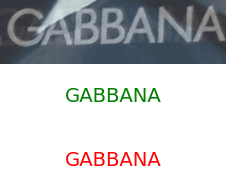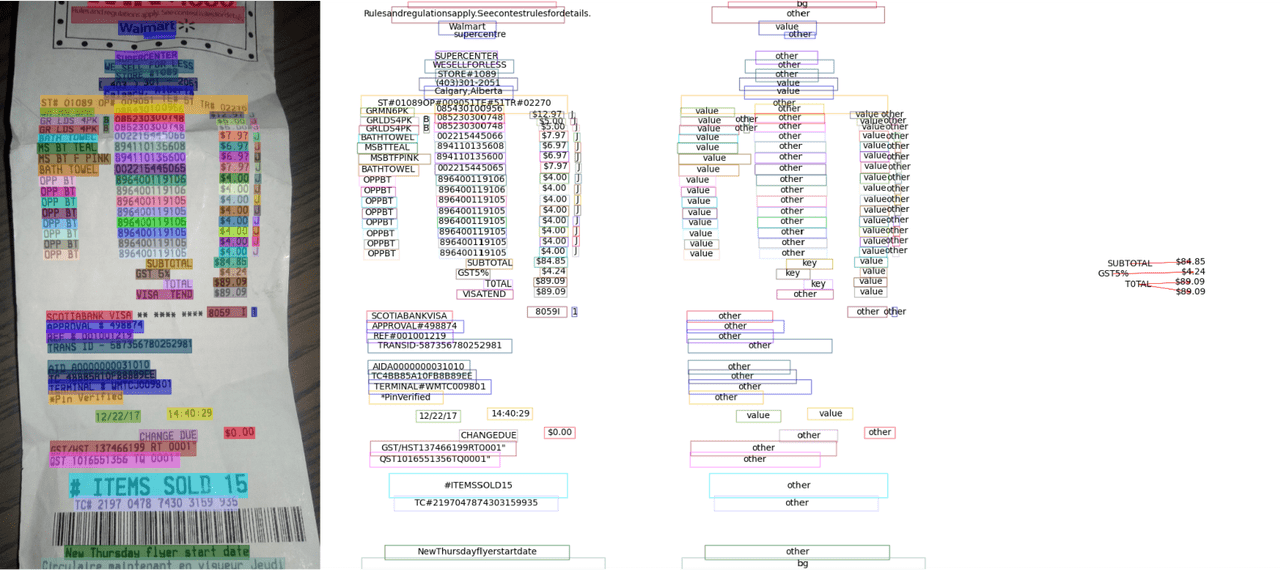Spaces:
Sleeping
Training and Testing
To meet diverse requirements, MMOCR supports training and testing models on various devices, including PCs, work stations, computation clusters, etc.
Single GPU Training and Testing
Training
tools/train.py provides the basic training service. MMOCR recommends using GPUs for model training and testing, but it still enables CPU-Only training and testing. For example, the following commands demonstrate how to train a DBNet model using a single GPU or CPU.
# Train the specified MMOCR model by calling tools/train.py
CUDA_VISIBLE_DEVICES= python tools/train.py ${CONFIG_FILE} [PY_ARGS]
# Training
# Example 1: Training DBNet with CPU
CUDA_VISIBLE_DEVICES=-1 python tools/train.py configs/textdet/dbnet/dbnet_resnet50-dcnv2_fpnc_1200e_icdar2015.py
# Example 2: Specify to train DBNet with gpu:0, specify the working directory as dbnet/, and turn on mixed precision (amp) training
CUDA_VISIBLE_DEVICES=0 python tools/train.py configs/textdet/dbnet/dbnet_resnet50-dcnv2_fpnc_1200e_icdar2015.py --work-dir dbnet/ --amp
If multiple GPUs are available, you can specify a certain GPU, e.g. the third one, by setting CUDA_VISIBLE_DEVICES=3.
The following table lists all the arguments supported by train.py. Args without the -- prefix are mandatory, while others are optional.
| ARGS | Type | Description |
|---|---|---|
| config | str | (required) Path to config. |
| --work-dir | str | Specify the working directory for the training logs and models checkpoints. |
| --resume | bool | Whether to resume training from the latest checkpoint. |
| --amp | bool | Whether to use automatic mixture precision for training. |
| --auto-scale-lr | bool | Whether to use automatic learning rate scaling. |
| --cfg-options | str | Override some settings in the configs. Example |
| --launcher | str | Option for launcher,['none', 'pytorch', 'slurm', 'mpi']. |
| --local_rank | int | Rank of local machine,used for distributed training,defaults to 0。 |
| --tta | bool | Whether to use test time augmentation. |
Test
tools/test.py provides the basic testing service, which is used in a similar way to the training script. For example, the following command demonstrates test a DBNet model on a single GPU or CPU.
# Test a pretrained MMOCR model by calling tools/test.py
CUDA_VISIBLE_DEVICES= python tools/test.py ${CONFIG_FILE} ${CHECKPOINT_FILE} [PY_ARGS]
# Test
# Example 1: Testing DBNet with CPU
CUDA_VISIBLE_DEVICES=-1 python tools/test.py configs/textdet/dbnet/dbnet_resnet50-dcnv2_fpnc_1200e_icdar2015.py dbnet_r50.pth
# Example 2: Testing DBNet on gpu:0
CUDA_VISIBLE_DEVICES=0 python tools/test.py configs/textdet/dbnet/dbnet_resnet50-dcnv2_fpnc_1200e_icdar2015.py dbnet_r50.pth
The following table lists all the arguments supported by test.py. Args without the -- prefix are mandatory, while others are optional.
| ARGS | Type | Description |
|---|---|---|
| config | str | (required) Path to config. |
| checkpoint | str | (required) The model to be tested. |
| --work-dir | str | Specify the working directory for the logs. |
| --save-preds | bool | Whether to save the predictions to a pkl file. |
| --show | bool | Whether to visualize the predictions. |
| --show-dir | str | Path to save the visualization results. |
| --wait-time | float | Interval of visualization (s), defaults to 2. |
| --cfg-options | str | Override some settings in the configs. Example |
| --launcher | str | Option for launcher,['none', 'pytorch', 'slurm', 'mpi']. |
| --local_rank | int | Rank of local machine,used for distributed training,defaults to 0. |
Training and Testing with Multiple GPUs
For large models, distributed training or testing significantly improves the efficiency. For this purpose, MMOCR provides distributed scripts tools/dist_train.sh and tools/dist_test.sh implemented based on MMDistributedDataParallel.
# Training
NNODES=${NNODES} NODE_RANK=${NODE_RANK} PORT=${MASTER_PORT} MASTER_ADDR=${MASTER_ADDR} ./tools/dist_train.sh ${CONFIG_FILE} ${GPU_NUM} [PY_ARGS]
# Testing
NNODES=${NNODES} NODE_RANK=${NODE_RANK} PORT=${MASTER_PORT} MASTER_ADDR=${MASTER_ADDR} ./tools/dist_test.sh ${CONFIG_FILE} ${CHECKPOINT_FILE} ${GPU_NUM} [PY_ARGS]
The following table lists the arguments supported by dist_*.sh.
| ARGS | Type | Description |
|---|---|---|
| NNODES | int | The number of nodes. Defaults to 1. |
| NODE_RANK | int | The rank of current node. Defaults to 0. |
| PORT | int | The master port that will be used by rank 0 node, ranging from 0 to 65535. Defaults to 29500. |
| MASTER_ADDR | str | The address of rank 0 node. Defaults to "127.0.0.1". |
| CONFIG_FILE | str | (required) The path to config. |
| CHECKPOINT_FILE | str | (required,only used in dist_test.sh)The path to checkpoint to be tested. |
| GPU_NUM | int | (required) The number of GPUs to be used per node. |
| [PY_ARGS] | str | Arguments to be parsed by tools/train.py and tools/test.py. |
These two scripts enable training and testing on single-machine multi-GPU or multi-machine multi-GPU. See the following example for usage.
Single-machine Multi-GPU
The following commands demonstrate how to train and test with a specified number of GPUs on a single machine with multiple GPUs.
Training
Training DBNet using 4 GPUs on a single machine.
tools/dist_train.sh configs/textdet/dbnet/dbnet_r50dcnv2_fpnc_1200e_icdar2015.py 4Testing
Testing DBNet using 4 GPUs on a single machine.
tools/dist_test.sh configs/textdet/dbnet/dbnet_r50dcnv2_fpnc_1200e_icdar2015.py dbnet_r50.pth 4
Launching Multiple Tasks on Single Machine
For a workstation equipped with multiple GPUs, the user can launch multiple tasks simultaneously by specifying the GPU IDs. For example, the following command demonstrates how to test DBNet with GPU [0, 1, 2, 3] and train CRNN on GPU [4, 5, 6, 7].
# Specify gpu:0,1,2,3 for testing and assign port number 29500
CUDA_VISIBLE_DEVICES=0,1,2,3 PORT=29500 ./tools/dist_test.sh configs/textdet/dbnet/dbnet_r50dcnv2_fpnc_1200e_icdar2015.py dbnet_r50.pth 4
# Specify gpu:4,5,6,7 for training and assign port number 29501
CUDA_VISIBLE_DEVICES=4,5,6,7 PORT=29501 ./tools/dist_train.sh configs/textrecog/crnn/crnn_academic_dataset.py 4
`dist_train.sh` sets `MASTER_PORT` to `29500` by default. When other processes already occupy this port, the program will get a runtime error `RuntimeError: Address already in use`. In this case, you need to set `MASTER_PORT` to another free port number in the range of `(0~65535)`.
Multi-machine Multi-GPU Training and Testing
You can launch a task on multiple machines connected to the same network. MMOCR relies on torch.distributed package for distributed training. Find more information at PyTorch’s launch utility.
Training
The following command demonstrates how to train DBNet on two machines with a total of 4 GPUs.
# Say that you want to launch the training job on two machines # On the first machine: NNODES=2 NODE_RANK=0 PORT=29500 MASTER_ADDR=10.140.0.169 tools/dist_train.sh configs/textdet/dbnet/dbnet_r50dcnv2_fpnc_1200e_icdar2015.py 2 # On the second machine: NNODES=2 NODE_RANK=1 PORT=29501 MASTER_ADDR=10.140.0.169 tools/dist_train.sh configs/textdet/dbnet/dbnet_r50dcnv2_fpnc_1200e_icdar2015.py 2Testing
The following command demonstrates how to test DBNet on two machines with a total of 4 GPUs.
# Say that you want to launch the testing job on two machines # On the first machine: NNODES=2 NODE_RANK=0 PORT=29500 MASTER_ADDR=10.140.0.169 tools/dist_test.sh configs/textdet/dbnet/dbnet_r50dcnv2_fpnc_1200e_icdar2015.py dbnet_r50.pth 2 # On the second machine: NNODES=2 NODE_RANK=1 PORT=29501 MASTER_ADDR=10.140.0.169 tools/dist_test.sh configs/textdet/dbnet/dbnet_r50dcnv2_fpnc_1200e_icdar2015.py dbnet_r50.pth 2The speed of the network could be the bottleneck of training.
Training and Testing with Slurm Cluster
If you run MMOCR on a cluster managed with Slurm, you can use the script tools/slurm_train.sh and tools/slurm_test.sh.
# tools/slurm_train.sh provides scripts for submitting training tasks on clusters managed by the slurm
GPUS=${GPUS} GPUS_PER_NODE=${GPUS_PER_NODE} CPUS_PER_TASK=${CPUS_PER_TASK} SRUN_ARGS=${SRUN_ARGS} ./tools/slurm_train.sh ${PARTITION} ${JOB_NAME} ${CONFIG_FILE} ${WORK_DIR} [PY_ARGS]
# tools/slurm_test.sh provides scripts for submitting testing tasks on clusters managed by the slurm
GPUS=${GPUS} GPUS_PER_NODE=${GPUS_PER_NODE} CPUS_PER_TASK=${CPUS_PER_TASK} SRUN_ARGS=${SRUN_ARGS} ./tools/slurm_test.sh ${PARTITION} ${JOB_NAME} ${CONFIG_FILE} ${CHECKPOINT_FILE} ${WORK_DIR} [PY_ARGS]
| ARGS | Type | Description |
|---|---|---|
| GPUS | int | The number of GPUs to be used by this task. Defaults to 8. |
| GPUS_PER_NODE | int | The number of GPUs to be allocated per node. Defaults to 8. |
| CPUS_PER_TASK | int | The number of CPUs to be allocated per task. Defaults to 5. |
| SRUN_ARGS | str | Arguments to be parsed by srun. Available options can be found here. |
| PARTITION | str | (required) Specify the partition on cluster. |
| JOB_NAME | str | (required) Name of the submitted job. |
| WORK_DIR | str | (required) Specify the working directory for saving the logs and checkpoints. |
| CHECKPOINT_FILE | str | (required,only used in slurm_test.sh)Path to the checkpoint to be tested. |
| PY_ARGS | str | Arguments to be parsed by tools/train.py and tools/test.py. |
These scripts enable training and testing on slurm clusters, see the following examples.
Training
Here is an example of using 1 GPU to train a DBNet model on the
devpartition.# Example: Request 1 GPU resource on dev partition for DBNet training task GPUS=1 GPUS_PER_NODE=1 CPUS_PER_TASK=5 tools/slurm_train.sh dev db_r50 configs/textdet/dbnet/dbnet_r50dcnv2_fpnc_1200e_icdar2015.py work_dirTesting
Similarly, the following example requests 1 GPU for testing.
# Example: Request 1 GPU resource on dev partition for DBNet testing task GPUS=1 GPUS_PER_NODE=1 CPUS_PER_TASK=5 tools/slurm_test.sh dev db_r50 configs/textdet/dbnet/dbnet_r50dcnv2_fpnc_1200e_icdar2015.py dbnet_r50.pth work_dir
Advanced Tips
Resume Training from a Checkpoint
tools/train.py allows users to resume training from a checkpoint by specifying the --resume parameter, where it will automatically resume training from the latest saved checkpoint.
# Example: Resuming training from the latest checkpoint
python tools/train.py configs/textdet/dbnet/dbnet_r50dcnv2_fpnc_1200e_icdar2015.py 4 --resume
By default, the program will automatically resume training from the last successfully saved checkpoint in the last training session, i.e. latest.pth. However,
# Example: Set the path of the checkpoint you want to load in the configuration file
load_from = 'work_dir/dbnet/models/epoch_10000.pth'
Mixed Precision Training
Mixed precision training offers significant computational speedup by performing operations in half-precision format, while storing minimal information in single-precision to retain as much information as possible in critical parts of the network. In MMOCR, the users can enable the automatic mixed precision training by simply add --amp.
# Example: Using automatic mixed precision training
python tools/train.py configs/textdet/dbnet/dbnet_r50dcnv2_fpnc_1200e_icdar2015.py 4 --amp
The following table shows the support of each algorithm in MMOCR for automatic mixed precision training.
| Whether support AMP | Description | |
|---|---|---|
| Text Detection | ||
| DBNet | Y | |
| DBNetpp | Y | |
| DRRG | N | roi_align_rotated does not support fp16 |
| FCENet | N | BCELoss does not support fp16 |
| Mask R-CNN | Y | |
| PANet | Y | |
| PSENet | Y | |
| TextSnake | N | |
| Text Recognition | ||
| ABINet | Y | |
| CRNN | Y | |
| MASTER | Y | |
| NRTR | Y | |
| RobustScanner | Y | |
| SAR | Y | |
| SATRN | Y |
Automatic Learning Rate Scaling
MMOCR sets default initial learning rates for each model in the configuration file. However, these initial learning rates may not be applicable when the user uses a different batch_size than our preset base_batch_size. Therefore, we provide a tool to automatically scale the learning rate, which can be called by adding the --auto-scale-lr.
# Example: Using automatic learning rate scaling
python tools/train.py configs/textdet/dbnet/dbnet_r50dcnv2_fpnc_1200e_icdar2015.py 4 --auto-scale-lr
Visualize the Predictions
tools/test.py provides the visualization interface to facilitate the qualitative analysis of the OCR models.
(From left to right: original image, text detection and recognition result, text classification result, relationship)
# Example 1: Show the visualization results per 2 seconds
python tools/test.py configs/textdet/dbnet/dbnet_r50dcnv2_fpnc_1200e_icdar2015.py dbnet_r50.pth --show --wait-time 2
# Example 2: For systems that do not support graphical interfaces (such as computing clusters, etc.), the visualization results can be dumped in the specified path
python tools/test.py configs/textdet/dbnet/dbnet_r50dcnv2_fpnc_1200e_icdar2015.py dbnet_r50.pth --show-dir ./vis_results
The visualization-related parameters in tools/test.py are described as follows.
| ARGS | Type | Description |
|---|---|---|
| --show | bool | Whether to show the visualization results. |
| --show-dir | str | Path to save the visualization results. |
| --wait-time | float | Interval of visualization (s), defaults to 2. |
Test Time Augmentation
Test time augmentation (TTA) is a technique that is used to improve the performance of a model by performing data augmentation on the input image at test time. It is a simple yet effective method to improve the performance of a model. In MMOCR, we support TTA in the following ways:
TTA is only supported for text recognition models.
python tools/test.py configs/textrecog/crnn/crnn_mini-vgg_5e_mj.py checkpoints/crnn_mini-vgg_5e_mj.pth --tta


